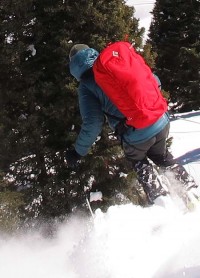
His Blogness skiing with Black Diamond Jetforce airbag pack. It's not going to help if he hits that tree, but then anything that prevents avalanche burial is a plus.
Chances of surviving an avalanche are grim so above all else we work on avoidance. We are super careful about route finding and terrain selection, and we’ve always got the basics (rescue gear, route planning, etc.).
A while back I attended an avalanche safety seminar that drilled some key points into my cranium, and helped reinforce our take. They also went into how to survive if you do get buried. Following from my notes — mid-winter safety check!
While skiing up or down, it is fundamentally important to expose as few people as possible to hazard at any given time. Preferably ONE person. Thus, smaller groups, traveling one-at-a-time when exposed to any avalanche hazard. Group size? Consensus seems to be that a trio might be the most effective number. Larger groups can function, but at some point they may need one clear leader such as a guide. Consider two-way radio communication no matter what your group size.
If you’re searching for avalanche victims:
– Make sure all rescuers’ beacons are on receive.
– Shut off beacons on victims as you find them.
– Stop and look around, up the slope and down as you follow your beacon signal.
– Scan the area, look for visual clues.
– Don’t forget the importance of probe searches – don’t dig twice.
– Practice shoveling technique. It’s just as important as using your beacon correctly.
Critical Points to Survival
If you’re caught in an avalanche, think SURFACE and AIR POCKET. Strive for the surface. Fight. But if possible when you sense the avalanche stopping and you’re buried, concentrate on getting your hands in front of your face and forcing an air pocket as you come to rest.
If you’re buried you must have an unblocked airway, or you’d better be rescued in the first few minutes and have your airway cleared. Know how this works so you know just how critical it is to somehow prevent inhaling snow or otherwise incurring a blocked airway. What happens is if you can’t breath, your heart stops soon after (acute asphyxia) — and you probably won’t make it. It’s like having a plastic bag tied over your head.
If your mouth or throat is not blocked, you might survive for up to 15 minutes and sometimes a bit more even without a large airpocket provided you can do at least a small amount of breathing — and depending on how quickly the ice mask forms around your face, which essentially smothers you. But you need a substantial airpocket or functioning Avalung to survive longer than 15-30 minutes. Food for thought: Beacon search, how many minutes? Then how long for shoveling?
For those of us who need a review: your exhalations contain a lot of CO2 carbon dioxide gas. It is poisonous. When you’re buried in an avalanche you may end up re-breathing the CO2 and it stops your breathing, then your heart. Quickly. Oxygen (normal air) is available in the snow around you when you’re buried in an avalanche. The crux is to dissipate or otherwise not re-breath the CO2.
Provided it’s not ripped out of your mouth during the avalanche, a Black Diamond Avalung may help. It allows you to inhale fresh air directly from the snowpack. Exhaled air is diverted away from your face which prevents ice mask formation and re-breathing of CO2. Fully buried test subjects maintained normal respiration for up to 90 minutes when using Avalung. That said, a common mistake in avalanche safety is to depend on equipment to save you. Read on.
Avalanche morbidity: 25% of survivors have traumatic injury. Most common injury is major orthopedic, soft tissue, craniofacial. Utah study of 28 avalanche death, 22 victims who died of asphyxiation, half had mild to moderate traumatic brain injury; 6 who died of trauma had severe traumatic brain injury.
Again, the idea is to not get caught.
With that in mind, we’re thinking Project Zero might be something we should be emphasizing in our space. An industry-wide project with the goal of ZERO avalanche fatalities, Project Zero is said to be modeled after a Swedish automobile safety initiative that reduced traffic deaths by half.
Commmenters, your take?
WildSnow Girl, Lisa Dawson, is the luckiest girl in the world. Also known as Mrs. WildSnow.com, she tests whatever gear she wants. She gives the WildSnow family of websites the feminine voice.
